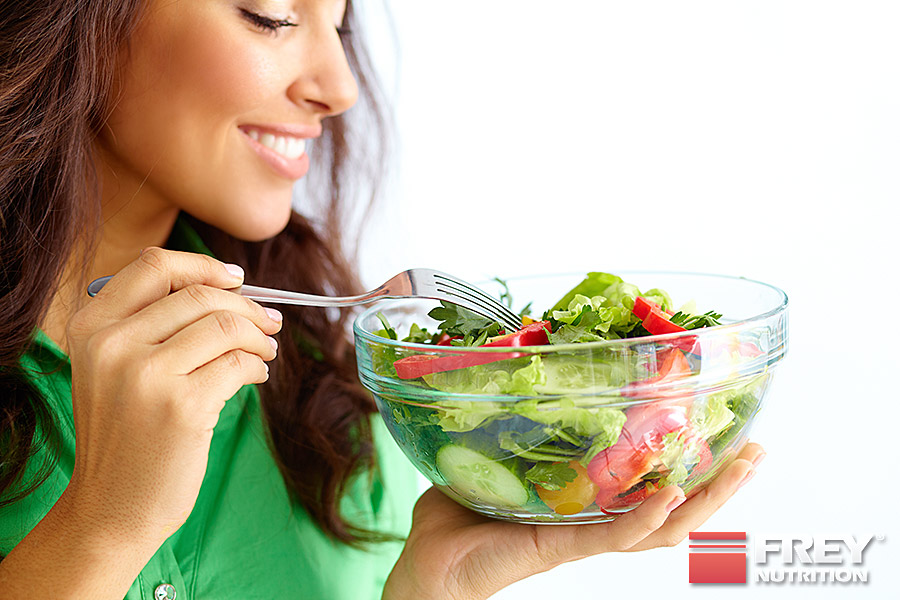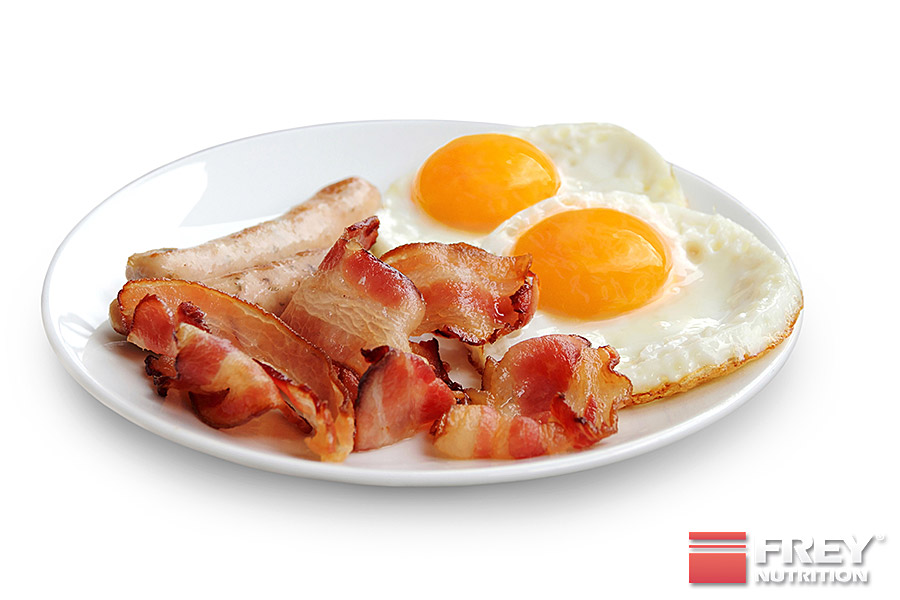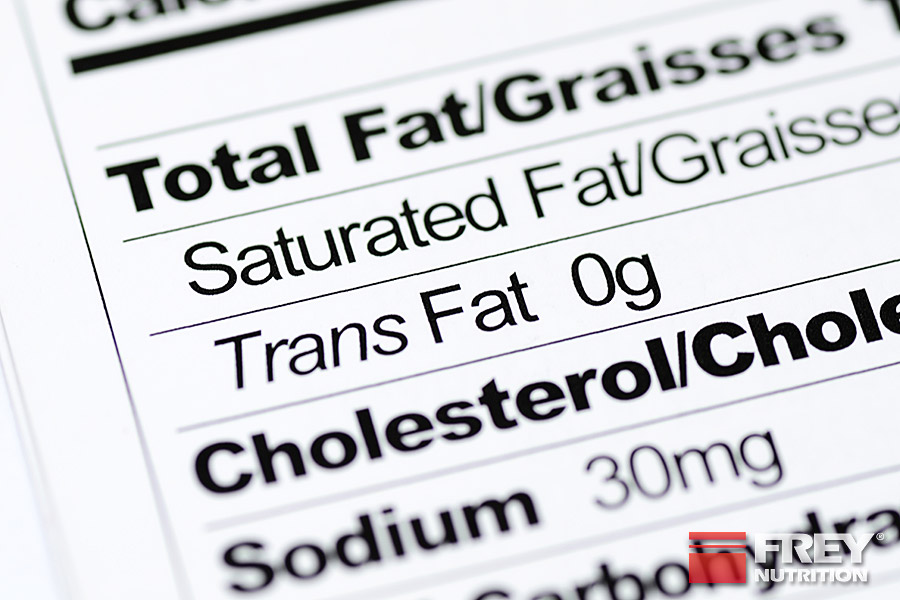THE TYPE OF FATTY ACIDS IS IMPORTANT
FATS ARE ONE OF THE THREE BASIC BUILDING BLOCKS OF OUR DIET, ALONG WITH PROTEINS AND CARBOHYDRATES. THEY ARE AN IMPORTANT ENERGY SUPPLIER FOR THE HUMAN ORGANISM. IDEALLY, 55-60 PERCENT OF ENERGY REQUIREMENTS ARE COVERED BY CARBOHYDRATES, 25-30 PERCENT BY FAT AND 10-15 PERCENT BY PROTEINS.
It is also important what type of fat is fed to the body, as fats differ in their structure and usability for the body and therefore affect the organism and metabolism differently. For example, you should make sure that the majority of the fat you consume consists of unsaturated fatty acids, because the body cannot produce these itself.
WHAT DOES PEOPLE NEED FATS FOR?
- AS AN ENERGY SOURCE: WITH AN ENERGY CONTENT OF 37.7 KJ = 9 KCAL/G, FAT IS THE MOST ENERGY-RICH FOOD SOURCE.
- AS MECHANICAL PROTECTION FOR ORGANS SUCH AS THE KIDNEY, LIVER AND BRAIN. FAT IS, SO TO SAY, AN INTERNAL PADDING OF THE BODY.
- FOR THERMAL PROTECTION FUNCTION.
- FOR THE ABSORPTION OF FAT-SOLUBLE SUBSTANCES, E.G. VITAMIN A, D, E.
- FAT CARRIES FLAVOR AND PROLONGS THE FEELING OF SATISFACTION AFTER EATING.
- AS AN ENERGY STORAGE: EXCESS FAT IS STORED AS A FAT DEPOSIT.
- FAT IS A BUILDING MATERIAL FOR ALL TYPES OF CELLS AND THEIR COMPONENTS.
- FAT IS A STARTING MATERIAL FOR MEDIATORS WITH INFLAMMATORY EFFECTS
WHAT HAPPENS TO FATS IN THE BODY?
In the mouth, the fats are broken down mechanically by chewing movements and enriched with an enzyme to break down the fats. However, this only becomes active in the acidic environment of the stomach. In the small intestine, the fats are then broken down into their components - fatty acids and glycerides. The resulting breakdown products are then absorbed into the intestinal cells via transport proteins. Their further path takes them either to be transported away via the lymphatic vessels or into the bloodstream to the liver. In biochemical degradation pathways, they are finally converted into energy or stored in fat deposits.
WHAT TYPES OF FAT ARE THERE?
On the one hand, a distinction can be made between animal and vegetable fats, which can be simple or complex. A distinction can also be made between fats with saturated, monounsaturated and polyunsaturated fatty acids.
SIMPLE FATS
Simple fats include neutral fats, compounds between fatty acids and glycerine. Depending on whether the glycerine particle is connected to one, two or three fatty acids, it is referred to as mono-, di- or triglycerides. The latter make up the main factor of dietary fats, accounting for 90 percent.
COMPLEX FATS
Complex fats include
- Phospholipids: Compounds of fatty acids and phosphoric acids for the construction of cell structure (e.g. lecithin, found in soybeans)
- Glycolipids: Compounds of fatty acids and carbohydrates for the construction of cell membranes and brain dry mass (e.g. cerebrosides)
- Lipoproteins: Fats that are surrounded by special proteins and thus enable the transport of fats in the blood. This is why they are also called blood fats (LDL, HDL). Since fat is not water-soluble in its normal state, it would clog the bloodstream without lipoproteins.
SATURATED AND UNSATURATED FATTY ACIDS
Depending on the degree of saturation, fatty acids are classified into saturated fatty acids, monounsaturated fatty acids and polyunsaturated fatty acids. The structure changes as the saturation increases. Liquid fats, such as oils, consist mainly of unsaturated fatty acids and solid fats, such as butter, consist mainly of saturated fatty acids.
SATURATED FATTY ACIDS
Saturated fatty acids are mostly found in animal products (e.g. meat, butter, cheese). They do not need to be consumed in large quantities through food, as the body can produce them itself. Too much saturated fatty acids increases LDL cholesterol ("bad cholesterol") and total cholesterol levels.
MONOUNSATURATED FATTY ACIDS
Monounsaturated fatty acids can also be produced by the body itself and are mainly found in vegetable oils (especially olive oil and rapeseed oil). They improve the balance of blood cholesterol levels. The "good cholesterol" HDL increases or remains constant. The "bad cholesterol" LDL is reduced.
POLYUNSATURATED FATTY ACIDS
Polyunsaturated fatty acids are also called essential fatty acids. Since the body cannot produce them itself, they must be supplied through food. A high intake of essential fatty acids lowers LDL and total cholesterol levels.
They are necessary for the construction of cell structures and transport units, regulate fat metabolism and are important for the formation of signaling substances (e.g. prostaglandins). Polyunsaturated fatty acids are divided into omega-6 fatty acids and omega-3 fatty acids:
OMEGA-3 FATTY ACIDS
- Alpha-linolenic acid: Found in linseed oil, rapeseed oil, soybean oil, walnut oil, dark green leafy vegetables and nuts)
- Eicosapentaenoic acid (EPA) and docosahexaenoic acid (DHA): Found in fatty fish from cold waters, such as mackerel, salmon and tuna. OMEGA-3 CAPS contain both EPA and DHA in high concentrations.
OMEGA-6 FATTY ACIDS
- Linoleic acid: Found in sunflower oil, safflower oil, pumpkin seed oil, corn germ oil and grape seed oil
- Arachidonic acid: Occurs in animal foods such as meat, offal, butter and egg yolk
FAT COMPANIONS
Fat also contains substances that accompany fat. These include lecithin, the fat-soluble vitamins A, D, E and K, carotenoids, steroid hormones and cholesterol. Cholesterol is an important building block of the cell membrane and a precursor to bile acids and some hormones. It is also important for the production of vitamin D. Cholesterol is only found in animal foods such as eggs, fatty meat, sausages and cheese. Since a high cholesterol level in combination with other risk factors increases the likelihood of vascular or cardiovascular disease, these foods should only be consumed in limited quantities. However, the level of cholesterol depends primarily on the body's own production and only secondarily on intake through food.
WHAT ARE TRANS FATTY ACIDS?
A typical by-product of (partial) fat hydrogenation are so-called trans fatty acids. They are mainly found in margarine, baking fats and products made with these fats, such as potato chips, puff pastry, biscuits and ready meals. It is now considered proven that trans fatty acids increase the risk of coronary heart disease (CHD) and sudden cardiac death. There is also strong evidence of a connection with other diseases, especially cardiovascular diseases.
If you see a product that has "partially hydrogenated vegetable fat" listed in its ingredients, it contains trans fats. However, there has been a trans fat regulation in Austria since 2009 that prohibits the marketing of products containing levels of trans fatty acids that are hazardous to health.
This means that all fats, oils and foods made from them may not contain more than two percent artificial trans fatty acids in the fat content.
HOW MUCH FAT DOES A PERSON NEED?
Dietary fats are important sources of energy, but can also increase the risk of certain diseases, such as cardiovascular disease. It therefore depends primarily on which fats and how much of them we consume. A fat-free diet is by no means advisable, as some fat components fulfil other important functions in addition to providing energy. The average fat requirement of an adult is around 30 percent of the amount of energy consumed, which corresponds to 65 g of fat for 2,000 kcal per day.
FOR EXAMPLE, 10 G OF FAT ARE CONTAINED IN:
= 10 G VEGETABLE OIL
= 12 G BUTTER OR MARGARINE
= 12 G MAYONNAISE
= 29 G CREAM
= 16 G NUTS
= 30 G FRENCH FRIES, CHIPS
= 30 G MILK CHOCOLATE
= 45G GOUDA
= 36 G LIVER SAUSAGE
= 40 G EXTRA SAUSAGE
= 250 G TURKEY HAM
= 5 KG CARROTS
Conversely, a portion of roast pork and a meatloaf sandwich each contain 27 g of fat, and a pair of frankfurters contain 26 g. One third of the fat should consist of saturated fatty acids and the rest of unsaturated or polyunsaturated fatty acids. The ratio of omega-6 fatty acids to omega-3 fatty acids should be approximately 5:1 or less, and the cholesterol intake should not exceed 300 mg. Trans fatty acids should only make up a maximum of one percent of energy intake, as they have exclusively negative effects on health.











